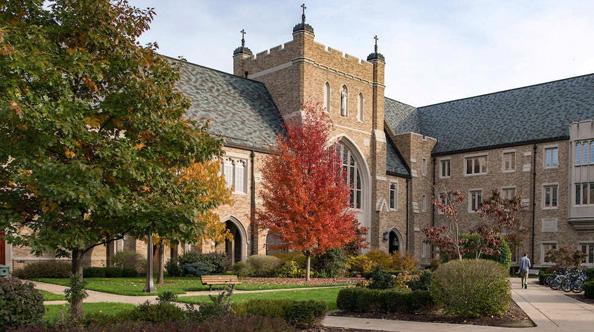Schneider improves building efficiency at University of Notre Dame
- July 7, 2020
- Steve Rogerson

Schneider Electric is helping the University of Notre Dame in Indiana improve operational efficiency by enabling remote management during Covid-19 shutdowns.
French firm Schneider is working with the university to implement EcoStruxure Building 3.0 in nearly 100 buildings across campus.
Havel, a division of Shambaugh and an Emcor company, is a Schneider master-level building management system (BMS) EcoXpert business partner and will be responsible for managing the project implementation. The university will benefit from increased levels of operational data visibility and control to manage building performance, occupant comfort and energy efficiency.
Known for its storied sports franchise as for its top academic ranking, the university has also set itself apart by its progressive adoption of technology to improve security, reduce costs, increase energy efficiency and enhance the campus experience.
Last year, the university undertook a modernisation project to upgrade its building management technology to increase operational efficiency. In consultation with Havel, the university decided to upgrade existing Schneider systems to EcoStruxure Building Operation 3.0 to improve IP connectivity, building analytics, integration with metering and facility operations, and cyber security.
This transition also allowed the university to bring existing product families into EcoStruxure Building with a user interface that overlays analytics for energy efficiency, occupant comfort and more.
Havel is installing 150 Schneider Smart X Controller AS-Ps, which perform functions such as control logic, and support communications and connectivity to IO and fieldbuses, enabling the transition to EcoStruxure Building Operation 3.0 before the end of 2020.
EcoStruxure Building Operation seamlessly facilitates the secure exchange of data from both Schneider and third-party systems. It lets the university replace network controllers, field devices and sensors in future construction. The platform’s built-in web interface provides anytime, anywhere access control and data management and visualisation tools to help administrators make smarter, insights-based decisions.
This was put to use when Covid-19 hit and the state of Indiana mandated a stay-at-home order in late March. The implementation of EcoStruxure Building Operation enabled the university’s facility team to manage its buildings remotely, allowing them to work seamlessly through the months that the campus has been shut down.
“The University of Notre Dame campus is the largest EcoStruxure Building project with Havel in the USA,” said Justin Lavoie, vice president of channel development at Schneider Electric. “This is due in large part to our on-going collaboration with Havel, a master BMS EcoXpert partner, who has implemented Schneider Electric technology on campus for more than 25 years. We’re excited to work with Havel to expand our EcoStruxure footprint at the University of Notre Dame, especially in support of its on-going work to improve efficiency and sustainability.”
Project planning began in 2019 and is expected to take eight to twelve months. The university decided to start the transition in the facilities department building to gain hands-on experience and then decide how to take it forward across the campus. The university has selected six buildings to upgrade and validate the conversion and implementation process.
In 2010, the university set a goal to halve its carbon footprint by 2030. Through the use of energy efficient practices, energy management and sustainable and distributed energy resources, it has already met its goals.
EcoStruxure Building provides the visibility, analytics and automated controls necessary to oversee and manage energy use, power quality and building performance to help the university maintain this level of sustainability while operating its facilities and providing occupant comfort once students, faculty and staff return to campus.
EcoStruxure Building Advisor leverages legacy and new IP controllers to collect and analyse data giving facility managers the insights to take action to improve energy efficiency, proactively address maintenance problems and correct occupant comfort issues.
EcoStruxure Energy Expert provides management of the university’s domestic hot water, domestic cold water, chilled water and steam usage. It monitors energy usage, while ensuring power availability and increasing power quality.
Another key component of this transformation is an IP network jointly developed by Cisco and Schneider. This brings IT and operational building control together and enables multiple EcoStruxure Building IP architecture topologies to integrate with existing building layouts. Havel installed the joint system at the university to enable faster data flow across the OT network, enhancing performance while maintaining stability and resiliency.
Havel has worked with the University of Notre Dame for more than 50 years, and is one of the largest BMS EcoXperts for Schneider Electric in the USA. The EcoXpert partner programme is a worldwide network of companies that offer local expertise and support. Trained and certified by Schneider, they are the implementation arms of EcoStruxure, an IoT-enabled open and interoperable architecture and platform, as well as Wiser connected technology for homes.
“World-class institutions deserve world-class services and support,” said Whitey Reed, director at Havel. “Our success with the University of Notre Dame is grounded in our reliability and dedication. Schneider Electric shares this same commitment to customer satisfaction and provides the technology and expertise needed to enhance building efficiency at the University of Notre Dame.”
As a result of its on-going support at the university, Havel relocated its South Bend location to a facility just 8km from campus, employing five software engineers, and has dedicated an additional 17 employees to work on this project.
EcoStruxure has been deployed in more than 450,000 installations, with the support of 9000 system integrators, connecting over a billion devices.





